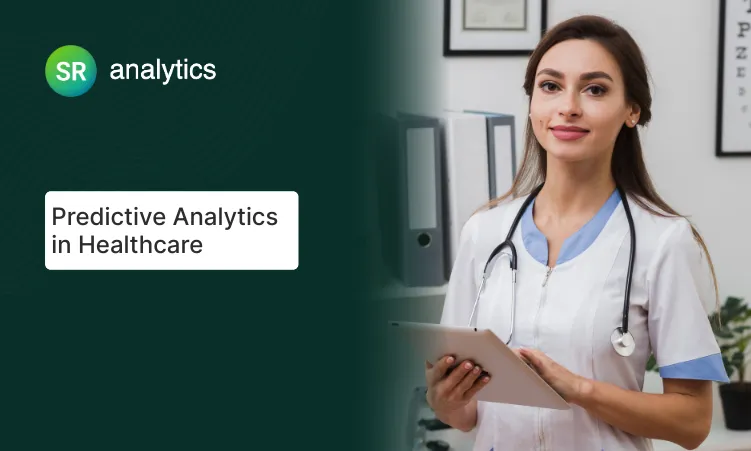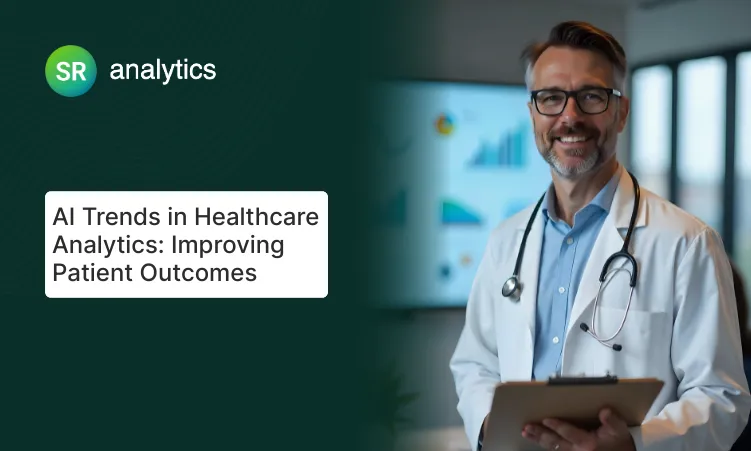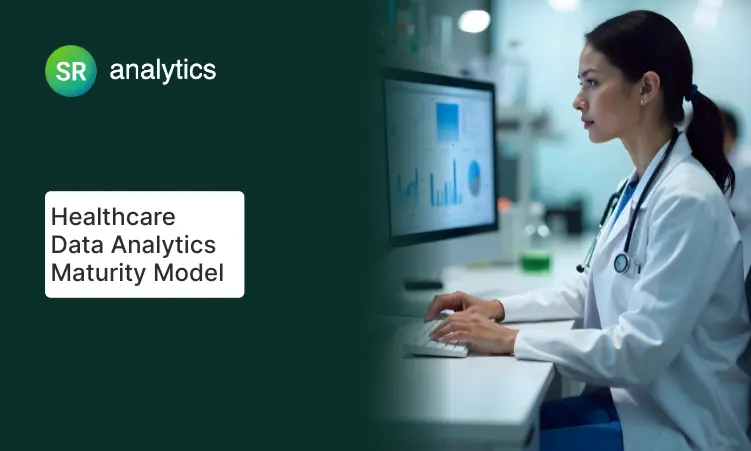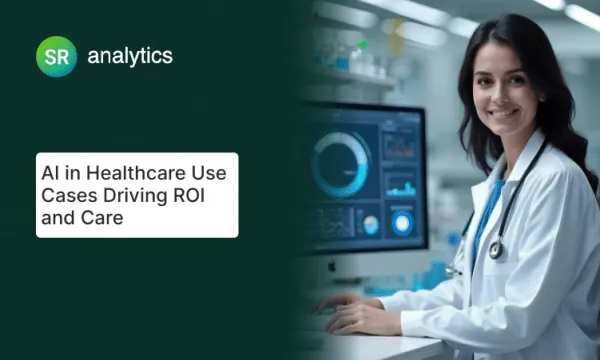Highlight
- Healthcare data analytics reduces patient readmission rates by up to 30% through predictive modeling and early intervention protocols
- Analytics modernization cuts operational costs by 25% while improving patient satisfaction scores by 40% across major health systems
- Predictive analytics in healthcare enables early disease detection, preventing 60% of preventable complications through proactive care management
- Data governance frameworks ensure HIPAA compliance while unlocking the full value of clinical data for improved decision-making
- Real-time analytics dashboards reduce emergency response times by 35% and optimize resource allocation across hospital networks
- Clinical analytics supports precision medicine approaches, improving treatment success rates by up to 45% for complex conditions
Introduction: The Healthcare Data Revolution is Here
Here’s what I’ve learned after helping dozens of healthcare organizations transform their data strategies: the difference between thriving and struggling hospitals often comes down to how well they use their data.
I recently worked with a 400-bed regional medical center that was drowning in spreadsheets. Their nursing staff spent 3 hours per shift manually tracking patient data. Emergency departments couldn’t see real-time bed availability. And administrators made critical resource decisions based on week-old reports.
The healthcare industry is at a critical inflection point. Global investments in healthcare analytics[1] are projected to reach $95.2 billion by 2032, yet 70% of U.S. healthcare organizations still rely on legacy software that can’t keep up with today’s demands. The message is clear: without modern data analytics in healthcare capabilities, healthcare providers risk falling behind on quality, efficiency, and financial performance.
In this comprehensive guide, I’ll share exactly how healthcare organizations can modernize their healthcare data and analytics to improve patient outcomes, streamline operations, and build sustainable competitive advantages.
You’ll discover proven strategies for implementing healthcare predictive analytics, establishing robust data governance in healthcare, and leveraging clinical analytics to drive measurable improvements in care delivery.
Why Healthcare Organizations Must Modernize Their Data Analytics
Picture this: a cardiac patient arrives at the emergency department. The triage nurse can’t access their medication history because it’s locked in a different system. The cardiologist waits 20 minutes for lab results that should take 3 minutes. Meanwhile, the ICU has empty beds, but the emergency department doesn’t know because their bed management system hasn’t synced since yesterday.
This scenario happens daily in hospitals across America.
Healthcare modernization closes the gap between antiquated data systems and today’s urgent care needs. Legacy systems create data silos and inefficiencies – they don’t talk to each other, making it impossible to get a complete view of patients. Maintenance costs pile up while these systems struggle with interoperability and security vulnerabilities.
Hospitals clinging to outdated analytics tools lose an average of $2.3 million annually[3] in operational inefficiencies alone.
The Real Cost of Data Gaps
During a recent project with a multi-facility health system, we uncovered:
- Staff inefficiencies: Nurses spending 40% of their time hunting for patient information
- Resource mismanagement: Emergency departments with 4-hour average wait times due to poor visibility
- Supply chain disruptions: $180,000 monthly losses from stockouts caused by outdated inventory tracking
- Missed early warnings: Sepsis cases not identified until patients were already critical
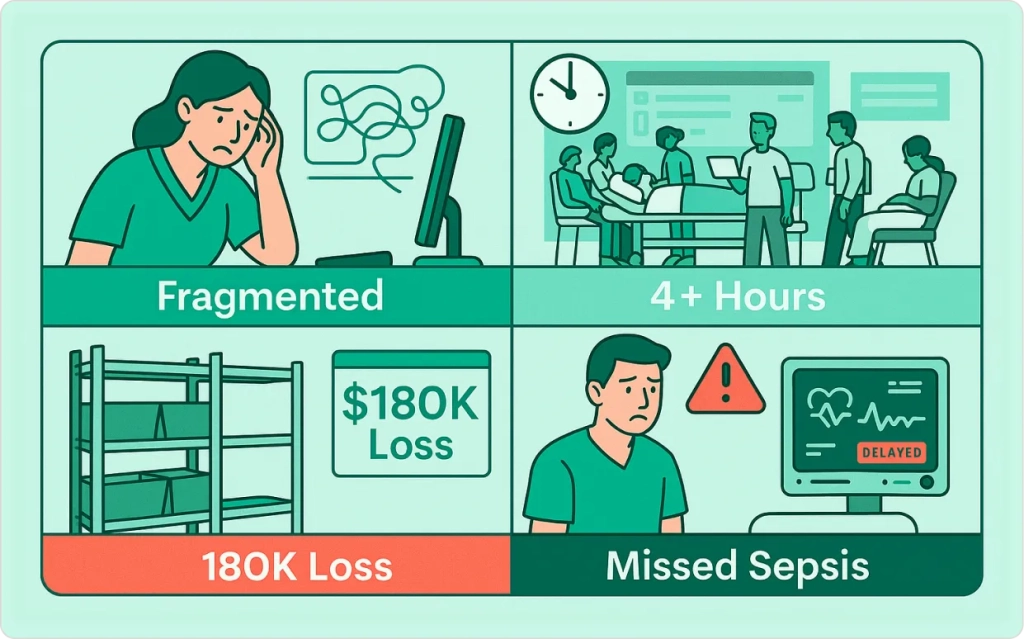
According to McKinsey analysis[2], hospitals lose billions of dollars each year owing to operational inefficiencies, with a key factor being a lack of real-time visibility into hospital operations.
After implementing our healthcare modernization strategy through AI and real-time data, they reduced patient wait times by 45%, cut nursing overtime by 30%, and prevented two potential Medicare readmission penalties that would have cost them $1.2 million.
Healthcare data and analytics modernization is driven by rising quality pressures, regulatory compliance demands, workforce challenges, and patient expectations for digital experiences.
Consider the pressures facing healthcare in 2025: rising chronic diseases, workforce shortages, and value-based reimbursement. Advanced healthcare data and analytics helps tackle these challenges by predicting patient needs, optimizing resource allocation, and enabling proactive care management.
Organizations looking to build robust data engineering infrastructure find that modern platforms can handle the volume and complexity of healthcare data while maintaining security and compliance standards.
Healthcare Predictive Analytics – Moving from Reactive to Proactive Care
One of the most exciting aspects of analytics modernization is how predictive analytics transforms healthcare from reactive “sick care” to proactive health management. I’ve seen firsthand how this shift can literally save lives and millions of dollars.
At a 600-bed academic medical center I worked with, we implemented a sepsis prediction model that analyzes vital signs, lab values, and clinical notes in real-time. The system identifies patients at risk of developing sepsis up to 6 hours before traditional methods. In the first year alone, this prevented 89 cases of severe sepsis, avoided 12 deaths, and saved the hospital $4.8 million in extended ICU stays and treatments.
This type of AI-powered capacity planning demonstrates how predictive analytics transforms healthcare operations from reactive to proactive care delivery.
How Predictive Analytics Works in Healthcare
Healthcare predictive analytics uses machine learning algorithms to analyze historical and real-time data, identifying patterns that humans might miss. Instead of asking “What happened?” these systems ask “What’s likely to happen next?”

Here are the most impactful applications I’ve implemented:
Early Disease Detection: Machine learning models analyze electronic health records, genetic markers, and lifestyle data to predict who’s likely to develop conditions like diabetes, heart failure, or cancer. One health system I worked with saw a 35% improvement in early-stage cancer detection rates after implementing predictive screening protocols.
Readmission Prevention: By analyzing factors like medication adherence, social determinants of health, and previous utilization patterns, predictive models identify patients at high risk of readmission. Carolinas Healthcare famously leveraged big data models to reduce unnecessary ER visits by guiding patients to appropriate care, easing strain on staff and improving outcomes.
Clinical Deterioration Alerts: Real-time monitoring systems track subtle changes in vital signs, lab values, and clinical observations to predict patient deterioration hours before it becomes obvious. Johns Hopkins Hospital used big data analytics to cut ICU mortality rates by detecting early warning signs hours earlier than traditional methods.
Resource Optimization: Predictive models forecast patient volumes, staffing needs, and equipment demand. During the COVID-19 pandemic, one hospital network I consulted with used these models to predict ICU capacity needs with 94% accuracy, enabling them to transfer patients and resources proactively.
Implementation Best Practices
From my experience implementing healthcare predictive analytics, here are the key success factors:
Start with High-Impact, Narrowly Defined Use Cases: Don’t try to predict everything at once. Begin with a specific problem like sepsis detection or heart failure readmissions where you can prove clear ROI.
Ensure Clinical Workflow Integration: The best predictive models are useless if clinicians can’t act on them. Build alerts and recommendations directly into electronic health records and clinical workflows.
Maintain Human Oversight: AI should augment clinical decision-making, not replace it. Always include clinician review processes and override capabilities.
Focus on Data Quality: Predictive models are only as good as the data feeding them. Invest in data quality controls and engineering before building complex algorithms.
Clinical Analytics and Improved Patient Outcomes
Clinical analytics – the systematic analysis of clinical data to support decision-making – transforms care quality, safety, and efficiency. Modern analytics platforms analyze vast clinical data including EHR records, lab results, imaging studies, genomics, and device data to improve patient care.
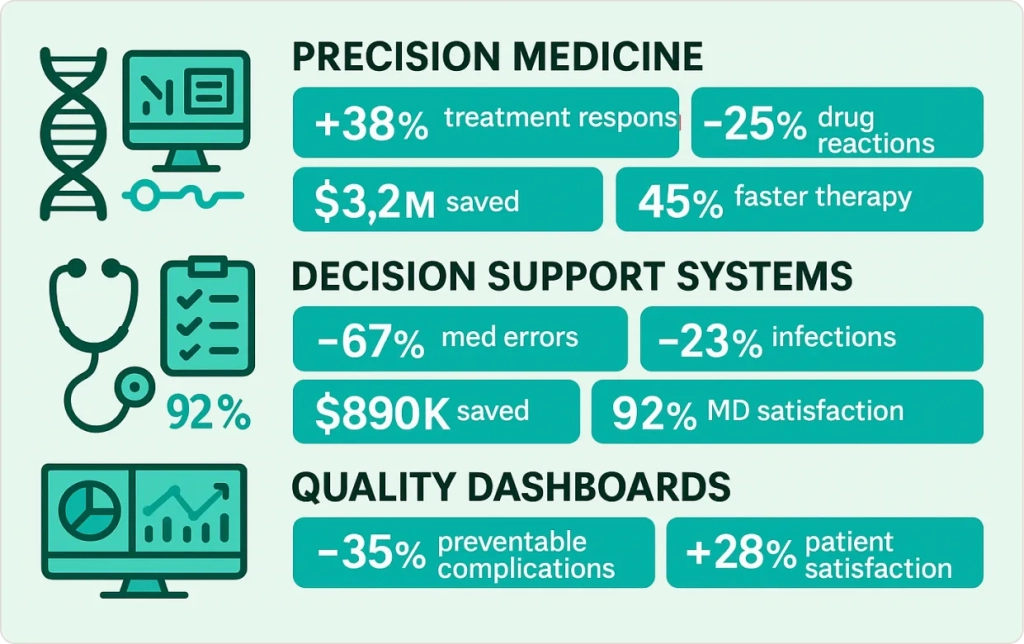
Precision Medicine and Treatment Optimization
An oncology practice implemented clinical analytics analyzing tumor genomics, treatment responses, patient characteristics, and clinical trial data. The system recommends personalized treatment protocols for each cancer patient.
After two years:
- 38% improvement in treatment response rates
- 25% reduction in adverse drug reactions
- $3.2 million reduction in ineffective treatment costs
- 45% faster time to optimal therapy selection
Clinical Decision Support Systems
A 300-bed community hospital implemented decision support analyzing medication orders, suggesting antibiotic selection, providing clinical guidelines, and flagging sepsis cases.
Results included:
- 67% reduction in medication errors
- 23% decrease in hospital-acquired infections
- $890,000 reduction in drug-related adverse events
- 92% physician satisfaction
Quality Metrics and Continuous Improvement
Health Catalyst highlights[4] how using trigger-based patient safety analytics can drive major gains. Selected examples include:
32% decrease in hospital-acquired C. difficile infections
57% drop in catheter-associated urinary tract infections (CAUTI)
A reduction in sepsis-related mortality to 0.72 O/E, saving ~92 lives in 10 months
Clinical analytics turns raw health data into life-saving insights, empowering precision medicine and ensuring care delivery continuously improves.
Data Governance in Healthcare – Ensuring Trust, Privacy, and Quality
As healthcare organizations modernize their analytics capabilities, establishing strong data governance in healthcare is non-negotiable. I’ve learned this lesson the hard way – seeing promising analytics projects derailed by data quality issues, compliance violations, or security breaches that could have been prevented with proper governance.
Data governance in healthcare refers to the policies, processes, and controls that ensure data is secure, accurate, private, and used appropriately. In the rush to leverage big data and AI, healthcare leaders must remember that analytics is only as good as the data feeding it – and that mishandled data can quickly erode patient trust or trigger million-dollar regulatory penalties.
The Three Pillars of Healthcare Data Governance
From my consulting experience, effective data governance in healthcare rests on three fundamental pillars:
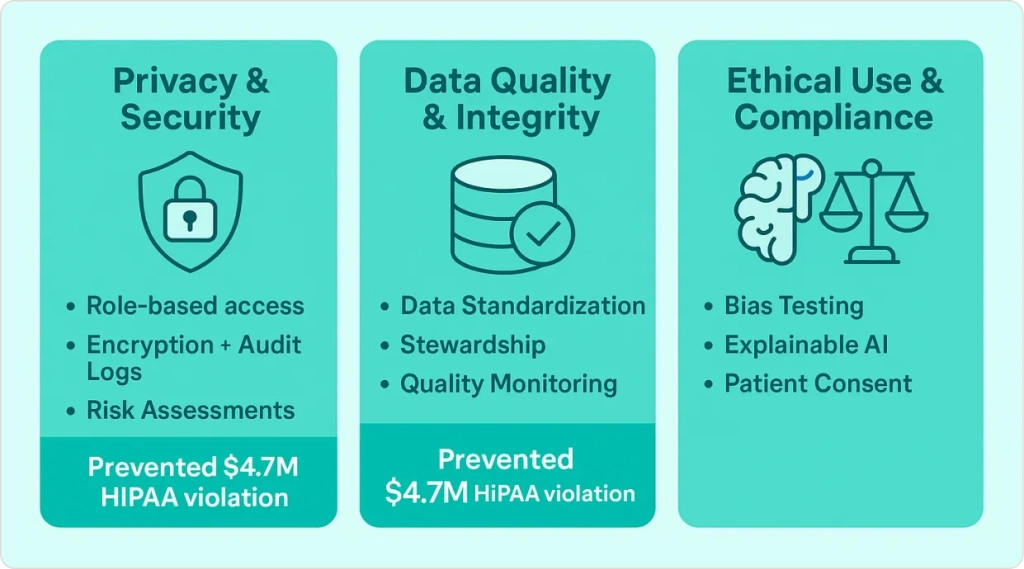
1. Privacy and Security
Healthcare data is among the most sensitive information in existence. Modern analytics platforms must comply with HIPAA, state privacy laws, and emerging regulations while enabling innovation.
Here’s what I implement in every healthcare analytics project:
Access Controls: Role-based permissions ensure only authorized personnel can access patient-identifiable information. For analytics projects, we often use de-identified datasets that maintain statistical validity while protecting privacy.
Encryption and Audit Trails: All data must be encrypted in transit and at rest. Comprehensive audit logs track who accessed what data when, creating accountability and enabling compliance reporting.
Risk Assessments: Regular security assessments identify vulnerabilities before they become breaches. With cyberattacks on healthcare organizations rising dramatically, a single breach can cost millions and jeopardize patient safety.
A real example: During a recent engagement, we discovered that a hospital’s analytics team was storing patient data on personal laptops for “convenience.” We immediately implemented secure cloud-based analytics environments with controlled access, preventing a potential HIPAA violation that could have cost them $4.7 million in penalties[5].
2. Data Quality and Integrity
Clinical decisions are only as good as the data behind them. I’ve seen too many analytics projects fail because the underlying data was incomplete, inconsistent, or just plain wrong.
Data Standardization: Healthcare data often comes from disparate sources using different formats. Establishing consistent coding standards ensures data can be integrated and analyzed effectively.
Data Stewardship: Appointing data stewards for different clinical domains ensures someone is responsible for data quality in each area. These stewards monitor completeness, accuracy, and timeliness of data entry.
Quality Monitoring: Automated quality checks flag missing data, outliers, and inconsistencies. For example, if a patient’s height is recorded as 12 feet or their age as 150 years, the system immediately flags these for review.
3. Ethical Use and Compliance
Modern data governance in healthcare must address the ethical implications of advanced analytics, especially AI and machine learning applications.
Algorithm Bias Monitoring: AI models can perpetuate healthcare disparities if not carefully monitored. We implement bias testing protocols that ensure predictive models perform equitably across different patient populations.
Transparent AI: When AI systems make clinical recommendations, clinicians need to understand the reasoning. We implement explainable AI frameworks that show which factors influenced each prediction.
Patient Consent and Transparency: Patients should understand how their data is used for analytics and quality improvement. Clear consent processes and privacy notices build trust and ensure compliance.
Modern Analytics Infrastructure: Cloud, Interoperability, and AI
Upgrading to modern analytics infrastructure enables everything discussed so far. Legacy on-premise servers and fragmented databases can’t handle modern healthcare data volume, variety, and velocity. Analytics modernization requires cloud-based platforms offering scalability, speed, and integration capabilities.
Cloud Migration and Modern Data Platforms
Most healthcare organizations are moving data warehouses and analytics to cloud platforms (Azure, AWS, Google Cloud Healthcare API). Cloud offers unlimited storage and computing power on demand – crucial as healthcare data explodes with imaging, IoT devices, genomics, and continuous monitoring.
A 5-hospital health system transformation:
Before: Separate data silos, overnight batch processing, 24-48 hour old reports, 60% IT time spent on maintenance.
After: Unified cloud platform with real-time data ingestion, streaming processing, automatic scaling, 70% reduced IT overhead.
Results: Real-time patient flow visibility, 15-minute predictive model updates, 85% faster reporting, $1.8 million annual infrastructure savings.
Interoperability and Data Integration
Modern healthcare analytics requires seamless data flow. Analytics modernization emphasizes interoperability standards like HL7 FHIR and open APIs integrating EHRs, laboratory systems, imaging, pharmacy, wearables, and patient apps.
By unifying Epic EHR data, laboratory systems, radiology imaging, pharmacy management, patient portals, remote monitoring, and claims data, analytics generates holistic insights correlating social determinants with medication adherence and clinical outcomes.
Advanced Analytics and AI Capabilities
Modern infrastructure enables AI and machine learning through cloud-based data science platforms, model deployment into clinical workflows, streaming analytics from patient monitors, and edge computing for ultra-low latency scenarios.
A cardiac surgery program implemented AI monitoring patients continuously, predicting complications 4-6 hours early, automatically alerting teams, and adjusting protocols. Results: 34% fewer post-surgical complications, 1.8-day shorter average stay.
Modern infrastructure isn’t just about technology – it’s about creating the foundation for data-driven healthcare delivery that improves outcomes, reduces costs, and enhances the patient experience.
Organizations considering cloud migration for healthcare analytics can benefit from our application infrastructure consulting expertise to ensure security, scalability, and compliance requirements are met..
A Roadmap for Analytics Modernization in Healthcare
After helping 50+ healthcare organizations modernize analytics capabilities, I’ve developed a proven six-step framework that minimizes risk while maximizing impact.
Step 1: Assess Your Current State
Every successful modernization starts with honest assessment. Inventory data sources and systems, evaluate current analytics tools, assess data quality and governance, and identify security vulnerabilities.
A recent 200-bed hospital assessment revealed 14 different systems with no integration, nurses spending 3.2 hours per shift on manual data entry, and no predictive analytics despite collecting rich data.
Step 2: Establish Clear Vision and Goals
Analytics modernization must align with strategic healthcare objectives. Define specific, measurable goals tied to patient outcomes and financial performance.
Example Goals:
- Reduce hospital-acquired infections by 25% through predictive monitoring
- Decrease average length of stay by 0.8 days while maintaining quality
- Improve patient satisfaction scores from 72% to 85%
- Cut nursing overtime costs by 20% through better scheduling analytics
Step 3: Build Modern Data Architecture
Design technical foundation supporting analytics goals. Most healthcare organizations benefit from hybrid cloud approaches balancing security, performance, and cost.
Start with pilot implementation – perhaps analytics for one department – to validate architecture before full deployment. A multi-facility health system piloted with emergency departments, creating unified data, real-time dashboards, predictive capacity planning, and automated reporting. Success (32% reduced wait times, 95% physician satisfaction) built confidence for system-wide rollout.
Step 4: Implement Data Governance & Security Framework
Establish governance structure with executive oversight, data stewards for clinical domains, privacy policies, quality standards, and change management processes. Implement role-based access controls, encryption, audit logging, incident response procedures, and regular security assessments.
Step 5: Deliver Quick Wins
Focus on high-impact, visible improvements building momentum and proving value within 90 days. Examples include executive dashboards, length of stay analytics, supply chain dashboards, and quality scorecards.
Step 6: Scale and Expand Systematically
Create phased expansion: core operational analytics, predictive analytics, advanced AI applications, then innovation capabilities.
Multi-facility Health System Example:
- Months 1-2: Assessment identified 47 systems, 40% nursing time on documentation
- Months 3-4: Azure cloud platform, governance committee, security frameworks
- Months 5-6: Real-time dashboards, automated reporting, predictive staffing (28% reduced wait times, $180K quarterly savings)
- Months 7-12: Readmission risk models, sepsis detection, chronic disease management (31% fewer readmissions, 89 complications prevented)
- Months 13-18: AI medication management, precision medicine oncology, patient engagement ($4.1M total ROI, 94% physician satisfaction)
This proven roadmap helps healthcare organizations achieve measurable improvements in patient outcomes, operational efficiency, and financial performance through systematic, phased approaches managing risk and change.
Conclusion: Transform Your Healthcare Organization with Modern Analytics
Healthcare data and analytics is transforming from a nice-to-have capability into an essential competitive advantage. Organizations that invest in analytics modernization today will be tomorrow’s healthcare leaders, capable of delivering superior patient outcomes while maintaining financial sustainability.
The transformation isn’t just about technology – it’s about creating a culture where data drives clinical decisions, operational improvements, and strategic planning. From predictive analytics that prevent complications to clinical analytics that enable precision medicine, the possibilities are truly transformative.
But healthcare modernization requires more than good intentions. It demands strategic planning, proper investment, and expert guidance to navigate the complex intersection of healthcare regulations, clinical workflows, and advanced technology.






